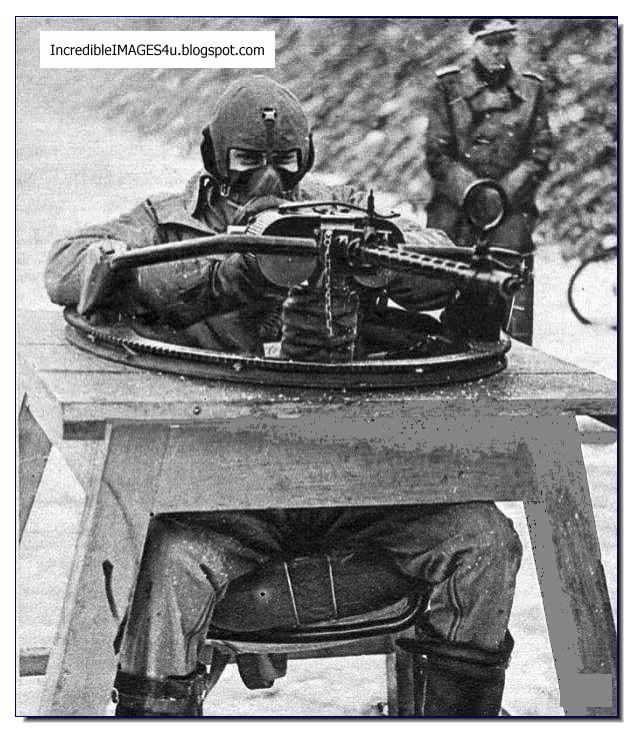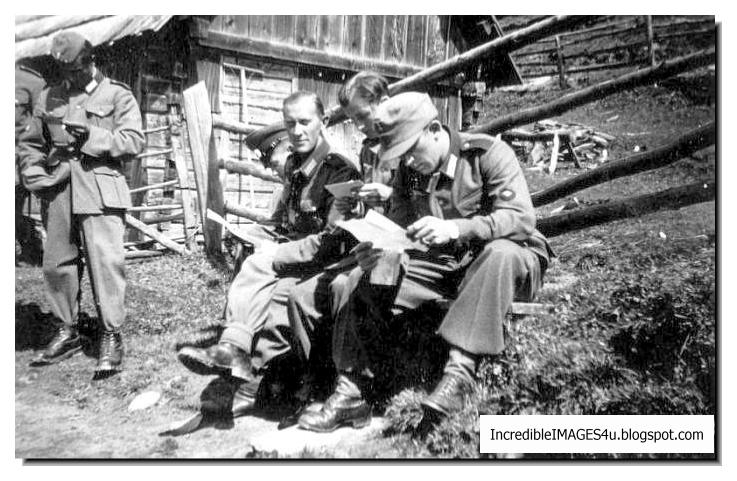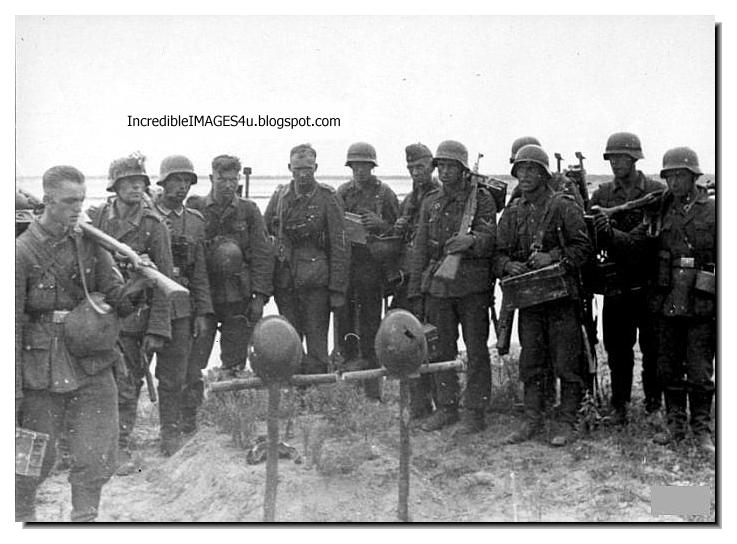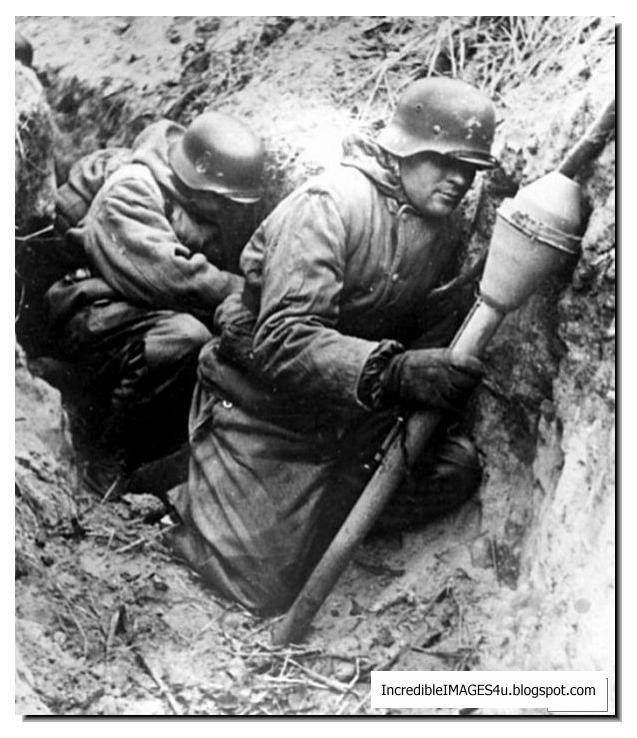German soldiers of the Hermann Goering Division walk past a destroyed "Elephant" tank near the Italian town of Nettuno
VIDEO: WEHRMACHT AND WAFFEN SS SOLDIERS IN ACTION
German soldiers look at the body of a Russian soldier. Eastern front.
Germans with a converted Soviet armored car BA 11
German tank trundle into position for an attack
Eastern Front. February 1944. Germans aboard a Pz.Kpfw IV tank
Loading 7.92 mm bullets on a German fighter plane
German soldiers bewildered, look at a skull on the turret of a T 34 tank
Germans at work with an Enigma machine
WHAT WAS A ENIGMA?
An Enigma machine is any of a family of related electro-mechanical rotor machines used for the encryption and decryption of secret messages. The first Enigma was invented by German engineer Arthur Scherbius at the end of World War I. This model and its variants were used commercially from the early 1920s, and adopted by military and government services of several countries — most notably by Nazi Germany before and during World War II. MORE>>>>
A Luftwaffe trainee learns to fire the MG 15 machine gun
THE MG 15 MACHINE GUN
The MG 15 was a German 7.92 mm machine gun designed specifically as a hand manipulated defensive gun for combat aircraft during the early 1930s. By 1941 it was replaced by other types and found new uses with ground troops.
MORE>>>>
The commander of the 3rd battalion of motorized regiment "Der Fuhrer" SS Division "Das Reich" SS Hauptsturmführer Vinzenz Kaiser (right) with officers on the Kursk Bulge, near a captured Soviet tank (A British-made "Churchill")
WHO WAS VINZENZ KAISER?
Vinzenz Kaiser was a Obersturmbannführer (Lieutenant Colonel), in the Waffen SS during World War II who was awarded the Knight's Cross of the Iron Cross. It was awarded to recognize extreme battlefield bravery or successful military leadership by Nazi Germany during World War II.

A SS Totenkopf soldier at work with an artillery range-finder
Finnish colonel (second from left) and officers of the Luftwaffe, the German high-speed landing barge in the waters of Ladoga. Also visible in the picture is a 20-mm German anti-aircraft gun FlaK 38.
German soldiers at a Swiss border post
East Prussia. 1945. January. German soldiers with assault rifles and a Stug-3 tank share a smoke.
Hitler would have frowned at this. German soldiers socialise with Russian women. Occupied Soviet Union.
Men of the First German Mountain Division ("Edelweiss") enjoy a vacation
A German motorcyclist rides past tanks moving deeper into Soviet territory. 1941.
German general Von Kleist welcomes an Italian general at the opening of the ferry services on the Dnieper river. Russia.
Two Wehrmacht officers play with a dog in Warsaw, Poland. 1941
German tanks move towards Stalingrad
August 1941. Freshly laid graves of slain German soldiers in the Smolensk area. Soviet territory.
Narva. Soviet Union. Germans moves alongside Tiger tanks.
Highly decorated German Major General Willy Langkeit with his men
WILLY LANGKEIT
Willy Langkeit (2 June 1907 – 27 October 1969) was an Generalmajor in the Wehrmacht during World War II, and one of only 882 recipients of the Knight's Cross of the Iron Cross with Oak Leaves. The Knight's Cross of the Iron Cross and its higher grade Oak Leaves was awarded to recognise extreme battlefield bravery or successful military leadership. Willy Langkeit was taken prisoner by American troops in May 1945 and transferred to British custody later that month. He was held until 1947 and later joined the Bundesgrenzschutz (Federal Border Guards) in 1951, retiring in 1967.
Hungary. December 1944. A SS man chats with a Hungarian soldier. Surprising they are so cheerful. The Russians were moving in. Standing in the background is a Tiger 2 tank
Stalingrad. A German soldier raises the Swastika over a captured building
German with the Wurzburg FuMG 62 radar on the French coast
WURZBURG RADAR
The Würzburg radar was the primary ground-based gun laying radar for both the Luftwaffe and the German Army during World War II. Initial development took place before the war, entering service in 1940. Eventually over 4,000 Würzburgs of various models were produced. It took its name from the city of Würzburg as the project leader liked geographical names.
Germans in Brest, Belarus. One of them seems interested in the lady standing afar
German soldiers march on the eastern front, cheerfully, it seems
Gathering solemnly around the graves of two fallen comrades
In the last last stages of the war. Outskirts of Berlin. Two battle-hardened SS men duck as the Russian artillery fires. One of the men has a Panzerfaust 60.
VIDEO: Panzerfaust
German soldiers look at the remains of a T-20 Komsomolet tractor artillery. Also seen are the remains of a Russian soldier who died desperately trying to extricate himself from the burning vessel
A German in action with a Gewehr 43 semi-automatic rifle
Soviet Union. 1941. Smolensk area. A German soldier has his head shaved by a comrade
The remains of a 122 mm howitzer. A dead Russian soldier lies alongside
1945. The last 4000 soldiers of the once formidable "Great Germany" division cross into Pillau, the last Wehrmacht stronghold in East Prussia. They defended the town till April 25, 1945, until they were overrun by the Soviet army.
Best From PicturesHistory.blogspot.com
Popular Articles On This Site
-
One young officer coming upon a unit that had overtaken a column of German refugees fleeing westward later recalled: ‘Women, mothers an...
-
The Einsatzgruppen were special SS mobile formations tasked with carrying out the mass murder of Jews, communist functionaries, and others...
-
Stalingrad. The word will, perhaps, will always remain synonymous with hardest war. Never was the war so brutal, so inhuman and fought so ...
-
The disaster of Stalingrad profoundly shocked the German people and armed forces alike...Never before in Germany's history had so l...
-
American soldiers and Vietcong fighters came face-to-face only during the fighting, some of it hand-to-hand. No photographer would be a...
-
The Hitlerjugend was Hitler's baby. The young boys who were groomed since the early 1930s did the most ferocious fighting in the war t...
-
War is hell. War is man at his worst. Most bestial. Death. Pain. Violence. When the dogs of war are unleashed.... A dead German so...
-
This is how the Nazi propaganda machine saw America VIDEO: NAZI PROPAGANDA A nurse from the American Army in France ...
-
The Battle Of Stalingrad lasted from July 17, 1942 to February 2, 1943. Two million Germans and Russians died. The entire city was des...
-
Hitler's Nazism is considered wrong on many counts (but there many today, who in private, admire it); the most evident fact is that Naz...
"Those who do not remember the past are condemned to repeat it."
-- George Santayana
History Quotes
May 1945 - If hell on earth existed, than it existed in Prague after May the 5th. 1945. Old men, women and children were beaten to death and maimed. Rapes, barbaric cruelties, horror-scenarios of hellish proportions - here they had been let lose.
- Ludek Pachmann, Czech Chess-Grand Master and publicist, forty years after the fact.
Copyright Issue
All the images on this site have been uploaded from the internet. Their copyrights lie with the respective owners.
If inadvertently any copy-righted material is published on this site, the owners of the material may contact us at balri24@gmail.com. We will remove the relevant portion immediately
Quotes
"History is a guide to navigation in perilous times. History is who we are and why we are the way we are."
-- DAVID C. MCCULLOUGH
History, despite its wrenching pain, cannot be unlived, but if faced with courage, need not be lived again.
-- MARY ANGELOU
Quotes
HISTORY, n. An account mostly false, of events mostly unimportant, which are brought about by rulers mostly knaves, and soldiers mostly fools.
-- Ambrose Bierce
We learn from history that we learn nothing from history.
-- GEORGE BERNARD SHAW
Quotes
"I have but one lamp by which my feet are guided, and that is the lamp of experience. I know no way of judging of the future but by the past."
--EDWARD GIBBON
"Patriotism ruins history."
-- GOETHE
Snippets from History
This short but important battle played a key role in the decision to use atomic bombs when attacking Hiroshima and Nagasaki. The battle showed just how far Japanese troops would go to defend their country.
Snippets From History
Paulus didn't give the order to 6th Army to surrender, but his troops no longer had much fight left in them. Resistance faded out over the next two days, with the last die-hards finally calling it quits. One Red Army colonel shouted at a group of prisoners, waving at the ruins all around them: "That's how Berlin is going to look!
"
Quotes
History is Philosophy teaching by examples.
-- THUCYDIDES
Quotes
"Those who cannot learn from history are doomed to repeat it."
-- George Santayana
Points to Ponder: Why Is China Unstable?
The aim of individuals in any society is money and power. Societies that give equal chance to all its members to get them will be the most stable. That is why democracies are more stable than other systems of governance.
China after Deng's reform gave the chance to get rich but power is in the hands of an elite; the Communist Party of China. Membership to the party is at the whims of the local party bosses. This leaves out many people who crave political power dissatisfied and disgruntled. There in lies the roots of instability. The Party suppressed these demands once at Tiananmen in 1989. But force is hardly the way to deal with things like these.
READ MORE: Tiananmen Square Massacre





































































2 Comments:
Good dokomentation . What a waste of good men
Talking about nazis ???
Post a Comment